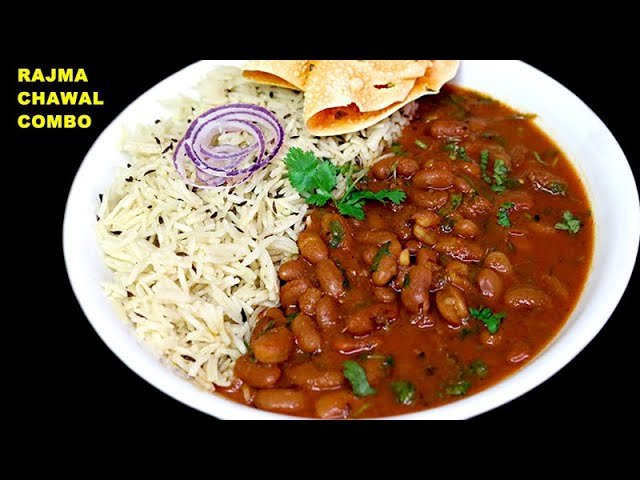A Comforting Hug in a Bowl
If you’ve grown up in North India, chances are that Sundays at home meant one thing—Rajma Chawal for lunch. That simple, wholesome combination of soft red kidney beans (rajma) simmered in a thick, flavorful tomato-onion gravy, served over steaming hot rice, has a way of making everything feel right in the world.
Rajma Chawal isn’t just food. It’s a tradition, a memory, and a feeling of being home. Whether it’s a rainy afternoon, a tired weeknight, or a weekend indulgence, this dish delivers comfort like few others can.
Let me walk you through my version of this classic—one that’s simple, tried and tested, and truly soul-satisfying.
What You’ll Need (Ingredients)
Let’s break the ingredients into parts so it’s easier to organize while cooking.
For the Rajma (Kidney Beans Curry):
- 1 cup rajma (red kidney beans), soaked overnight
- 3 cups water (for pressure cooking)
- 1 black cardamom (optional, but adds depth)
- 1 bay leaf
- Salt to taste
For the Gravy (Masala):
- 2 tablespoons oil or ghee (for a richer taste)
- 1 teaspoon cumin seeds (jeera)
- 1 large onion, finely chopped
- 1 tablespoon ginger-garlic paste (freshly crushed is best)
- 2 to 3 medium tomatoes, finely chopped or pureed
- 2 green chilies, slit or chopped (optional)
- 1/4 teaspoon turmeric powder
- 1 teaspoon red chili powder (adjust to taste)
- 1 teaspoon coriander powder
- 1/2 teaspoon garam masala
- Salt as needed
- Fresh coriander leaves for garnish
For the Chawal (Steamed Rice):
- 1 cup basmati rice
- 2 cups water
- Salt to taste
- 1 teaspoon oil or ghee (optional)
Step-by-Step Recipe
Step 1: Soak and Cook the Rajma
First things first—rajma needs to be soaked. This is non-negotiable. It helps the beans cook faster and become soft from the inside.
- Take 1 cup of rajma, rinse it well a few times until the water runs clear.
- Soak it in 3–4 cups of water overnight or for at least 8 hours.
- The next morning, drain the water, rinse once again, and it’s ready to cook.
Now pressure cook the soaked rajma:
- Add the rajma to a pressure cooker with 3 cups of fresh water.
- Throw in a bay leaf, a black cardamom (if using), and about ½ teaspoon of salt.
- Close the lid and pressure cook on medium heat for 5–6 whistles. If your rajma is old or extra hard, you may need 1–2 more whistles.
- Let the pressure release naturally.
Check for doneness: Take a bean and press it between your fingers—it should mash easily. If it’s still a little hard, cook for 1–2 more whistles.
Step 2: Cook the Masala (The Flavor Base)
This part is what brings all the magic. Take your time here and don’t rush.
- In a heavy-bottomed kadhai or deep pan, heat 2 tablespoons of oil or ghee.
- Add cumin seeds and let them crackle.
- Add finely chopped onions and cook on medium heat till they turn golden brown. This will take around 7–10 minutes. Stir often.
- Now add ginger-garlic paste. Sauté until the raw smell goes away—about 1–2 minutes.
- Time to add the tomatoes. You can either finely chop them or puree them (I prefer pureed for a smoother curry).
- Add in the green chilies (if using), turmeric, red chili powder, coriander powder, and some salt.
- Cook everything on medium-low heat. Stir occasionally. You’ll know it’s ready when the oil begins to separate and the masala thickens—this usually takes 10–15 minutes.
Pro Tip: If the masala starts sticking to the bottom, sprinkle a few drops of water and keep cooking.
Step 3: Bring It All Together
Now comes the best part—bringing the rajma and masala together into one delicious curry.
- Add the cooked rajma along with the water it was boiled in into the masala.
- Stir gently. Let it simmer uncovered or partially covered on low heat for at least 20–25 minutes. Longer if you have the time.
- The rajma will soak up all those delicious spices, and the curry will thicken beautifully.
- Adjust the salt and spice at this stage. If you like a thinner gravy (some people do with rice), you can add a little hot water.
- Once the rajma is soft, flavorful, and the curry has reached your preferred consistency, finish with ½ tsp garam masala and a handful of fresh chopped coriander leaves.
Step 4: Make the Chawal (Rice)
While the rajma is simmering away, make the rice. Plain steamed basmati rice is the perfect companion.
- Rinse 1 cup basmati rice 3–4 times until the water runs clear. Soak it for 15–20 minutes (optional, but helps with fluffiness).
- In a pan, boil 2 cups of water with a pinch of salt.
- Add the drained rice to the boiling water.
- Cook uncovered on medium-high until 90% water is absorbed.
- Then lower the heat, cover, and let it steam for another 5 minutes.
- Fluff with a fork before serving.
Shortcut Tip: You can also cook rice in a rice cooker or pressure cooker—2 whistles on low heat after the first whistle should do the trick.
Serving Rajma Chawal
Now that everything’s ready, here’s how to serve it the traditional way:
- Take a generous helping of hot rice in a bowl or plate.
- Pour ladlefuls of steaming rajma curry on top.
- Garnish with coriander.
- Add a spoon of homemade ghee (optional but heavenly).
- Serve with sliced onions, green chilies, or a simple cucumber raita on the side.
Some people love a piece of mango pickle on the side too. It balances the richness with a tangy kick.
Extra Tips & Variations
- Soaking Time: Always soak rajma overnight. If you forget, soak in hot water for 2 hours minimum, but overnight is best.
- Rajma Type: Kashmiri rajma (small, red) cooks faster and absorbs flavor better than the larger variants.
- Make It Vegan: Just use oil instead of ghee.
- Meal Prep: You can make the masala base in advance and store it in the fridge for up to 3 days. Boiled rajma can also be frozen.
Why We Love Rajma Chawal
There’s something universally comforting about this meal. It’s hearty but simple. Flavorful, but not fussy. It’s one of those dishes where the love shows in the time taken to let things simmer.
For many, rajma chawal isn’t just a recipe. It’s mom’s cooking. It’s school holidays. It’s Sunday afternoons with your favorite TV show. It’s home.
Whether you’re new to cooking or have made this a hundred times, there’s always a way to make it a little more personal—less chili, more tomatoes, extra coriander… You’ll find your signature style.
So the next time you’re craving something warm, comforting, and full of flavor—make rajma chawal. Let it simmer slowly, fill your kitchen with that familiar aroma, and enjoy every bite.

